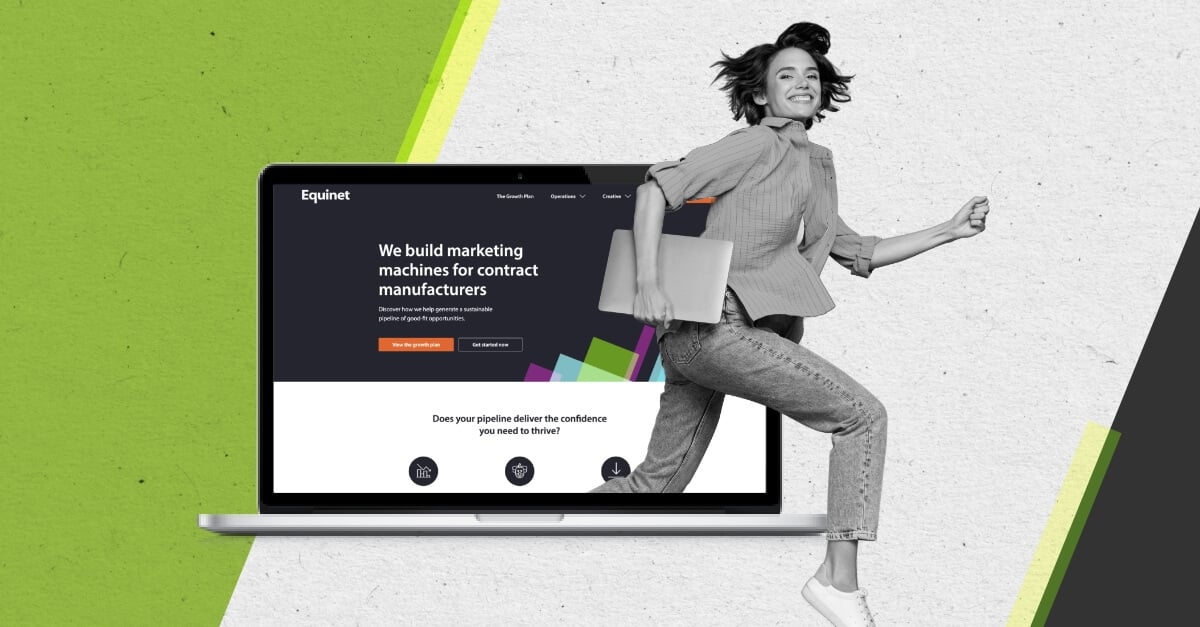
Build a website that supports the story you are trying to tell, and your customers will ‘get’ what you do or offer. Construct a site that’s hard to read and not clearly signposted and you run the risk of losing that potential customer in a flash.
We can ensure that the former comes true through not only the words on the page but the visual language too.
Before we continue though, visual storytelling is not just about getting your crayons out and drawing pretty shapes (although that’s definitely the fun part of my job). It’s a strategic, thought-led process and one that I’m really proud to be part of. UX (User Experience) Design is part of ‘the package’ when you get a website created and built by an agency like Equinet.
B2B companies are competing to have the smartest, slickest websites built to order. And it’s no surprise when a website built using a good UX-led strategy has the potential to raise conversion rates by as much as 400%. Cue the UX designer! In this blog we delve into 5 ways that can help you engage with your audience more effectively through visual storytelling and give your website that much needed boost.
1. Make your website pages easier to read with a clear structure
The problem: Cluttered text and poorly designed web pages cause confusion for potential customers. They are likely to leave your site before they get to the heart of the message you are trying to get across to them.
The solution: Remove all of the hot air in your content and enable your vision to breathe on the screen.
If you do have a lot of information to get across, consider what the viewer will read when they first cast their eyes across the page:
- Is it engaging?
- Is it attractive to the eye?
- Does it say something that communicates what you’re trying to get across in just a few words or a simple graphic?
How else can we help to visually improve a page containing lots of information?
- Infographics - key data and information worked into an easily digestible graphic that is engaging and attention-grabbing
- Bullet point or numbered lists - a textual but creative way of splitting up information
- Imagery - A picture can tell a thousand words, but only when it’s clear, relevant and on-brand
2. Be creative - You’ll see your business in a different light
Coming up with strategic led concepts to wow your viewers and convert them into customers is what UX designers love to do. You certainly don’t want to bore your audience with a dull website, so having an eye-catching design which leaves a lasting impression is key. Remember also, creative designs can be simple too. Less can also mean more.
It’s time to jazz things up a bit!
Your UX designer can help you to realise that there is more to creativity than just pretty pictures. It’s about giving your ideas an edge, making them stand out from the crowd, and quite importantly, visually communicating your message through an easy to navigate design.
3. Get emotive and tell your story on your customers level
Talk to your customer through the story that your brand or business is trying to convey.
This may be through:
- Colour selection - colours can be emotive
- Imagery - cheesy stock photography will only get you so far
- Narrative - let the customer know you are the expert in your field through the story you tell
A happy customer is likely to return, and making their ‘journey’ easy to travel along is the intention of a UX designer. A designer encapsulates written words into an engaging visual, usually based on buyer persona data. These are documents we create to visualise and better understand your target audience. We can then target the creative to the people that will be engaging with it. We sign post readers to key information and shout out the messages you need to stand out.
Making your communications targeted, clear and concise helps encourage customer loyalty, and promotes good customer satisfaction.
4. Build your brand identity based on your narrative
Developing a brand is a key step in building any business, but one that is sometimes overlooked.
Keeping things consistent is important in making your brand recognisable, so make sure you have elements which link your collateral together so they feel connected to any viewer hopping between a website and an ebook, for example. A UX designer can help align your website and advise the best way to bring all of your creative together.
What is collateral: A creative and marketing term to describe a group of items which sit together to form a campaign or branded set of designs.
5. Keep your customers engaged through your storytelling
Picture a “shop front”. This is the welcoming entrance that entices walkers by. It is the clean, well-lit display letting people know what it is you do or sell with special offers shouting out with a call to action. A website is your digital shop front, and you need to take equally the same amount of care in its design as you would a physical one.
When we create websites, we want your visitors to interact with the content on them. Whether it be reading quality, informative content, or filling in a form to learn more about your offering, our end game is to get your audience to engage with you.
Once they are ‘hooked’ you can then talk to them on their level, like we spoke about in Step 3 (getting emotive). Don’t forget your buyer personas can also help a lot with gauging what language and tone will be required to communicate effectively.
So… where to next?
If you’re not already reaping the benefits of good visual storytelling, I hope this blog has helped you to understand the importance of engaging with your customers through a strong and consistent brand presence, and how UX creative-led content can help to drive growth.
If you’d like to learn more or have any questions, drop us a line here or why not check out our Website UX & UI page where you can find out more on the subject.


